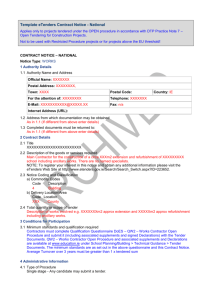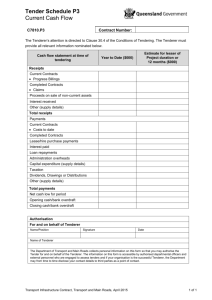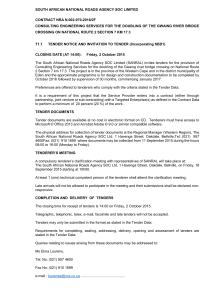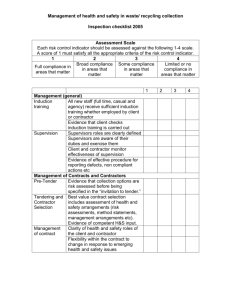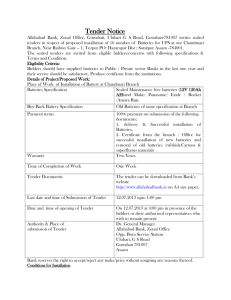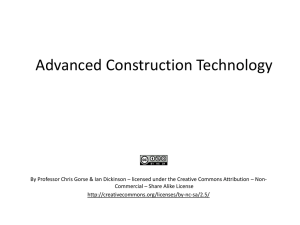Dumbwaiter Lift Specification
advertisement
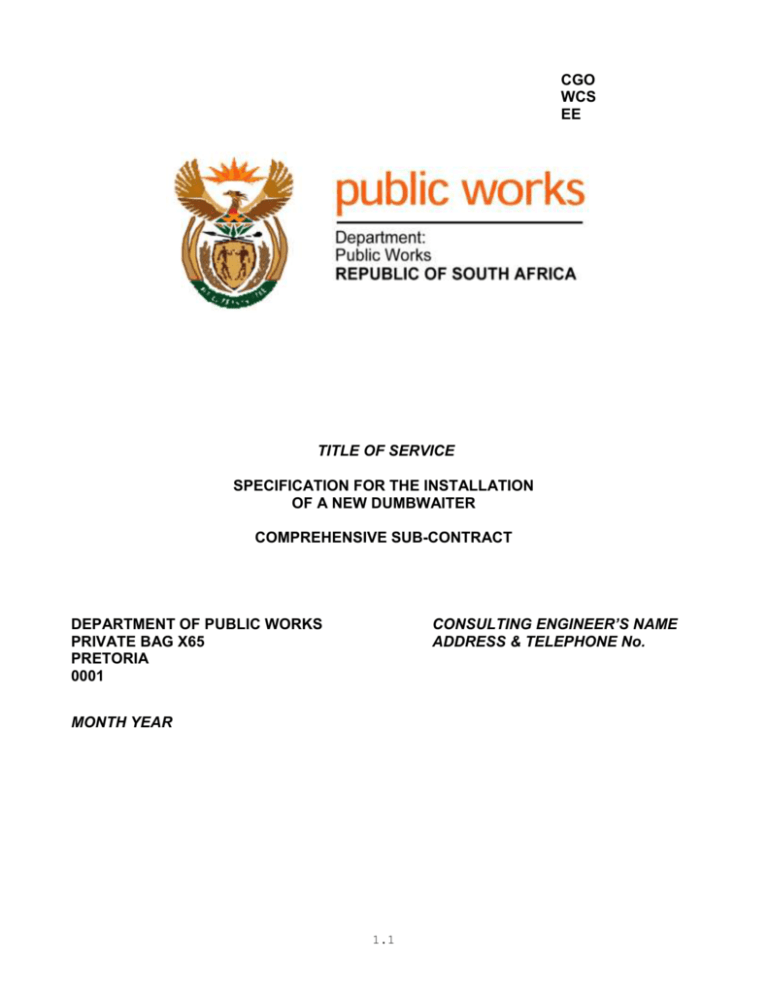
CGO WCS EE TITLE OF SERVICE SPECIFICATION FOR THE INSTALLATION OF A NEW DUMBWAITER COMPREHENSIVE SUB-CONTRACT CONSULTING ENGINEER’S NAME ADDRESS & TELEPHONE No. DEPARTMENT OF PUBLIC WORKS PRIVATE BAG X65 PRETORIA 0001 MONTH YEAR 1.1 TITLE OF SERVICE SPECIFICATION FOR THE INSTALLATION OF A NEW DUMBWAITER TABLE OF CONTENTS DESCRIPTION PAGE 1. Specification for the Installation of a new Dumbwaiter Part 1 – General Requirements 1-1 – 1-6 2. Specification for the Installation of a new Dumbwaiter Part 2 – Detailed Requirements 2-1 – 2-6 3. Specification for the Installation of a new Dumbwaiter Part 3 – Schedule of Technical Information 3-1 – 3-4 4. Specification for the Installation of a new Dumbwaiter Part 4 – Price Schedules 4-1 – 4-5 5. Annexure A – Materials Offered Ex-Import 6. Annexure B – evaluating Maintenance Costs in Tenders for Certain Electrical and Mechanical Installations where the Maintenance of Proprietary Items is Involved 7. Comprehensive Maintenance Contract – Articles Of Agreement (Not to be signed at tender stage) 8. Annexure C – State Tender Board: Preference Certificate for Local Manufacturing 9 Drawings EExxxx/L1 EExxxx/L2, etc. 1.2 A.1 1 5-1 – 5-* 1-3 TITLE OF SERVICE SPECIFICATION FOR THE INSTALLATION OF A NEW DUMBWAITER PART 1 GENERAL REQUIREMENTS 1.1 TYPE OF CONTRACT This contract will be a domestic sub-contract to be executed by the successful tenderer who will become the "Sub-Contractor", as referred to in this document under contract to the Main Contractor, referred to as the “Contractor” who will be awarded the contract for the execution of the entire project. 1.2 IMPORTED EQUIPMENT This equipment will not be subjected to fluctuations in the rate of exchange. However, should the Contractor choose to be protected against fluctuations in the rate of exchange on imported equipment, the following conditions will apply: a) The Materials Offered Ex-Import (Annexure A), which forms part of this tender document, must be completed by the Contractor. b) Any fluctuations in the rate of exchange will be for the account of the Government and shall be calculated from a date seven (7) days prior to the date of the Contractor’s tender to a date seven (7) days after receipt by the Contractor’s bank of the negotiable bill of lading or the exporter’s invoice, provided this latter date is not later than 30 days after the date of payment. Thereafter, fluctuations in the rate of exchange shall not be for the account of the Government. 1.3 CONTRACT WORK The installation shall be carried out by the sub-contractor’s own staff and shall not in any way be sub-let. 1.4 SCOPE OF WORK This contract covers the items as described below and shall include the supply, delivery, installation, testing and commissioning of all or any combination of the items of equipment listed hereunder as well as twelve months free maintenance after completion of the installation. Details of the lift shafts, machine rooms, escalator floor openings, etc. are to be determined on site in consultation with the electrical consultant. 1.3 1.5 MAINTENANCE After first delivery of the lift, there will follow a 12-month free maintenance period as per clause 2 of PW379. After the final delivery has taken place and the Comprehensive Maintenance Contract having been entered into, the tendered comprehensive maintenance price adjusted in accordance with the Articles of Agreement will be paid. 1.6 LOCAL CONDITIONS Tenderers must acquaint themselves fully with the situations, the local conditions and the requirements of this specification. Later claims by the successful tenderer for extra payment arising out of under-estimating any of the requirements will not be considered by the Department. 1.7 WORK SURROUNDING THE DUMBWAITER INSTALLATION *The work surrounding the Dumbwaiter installation will consist of the following: 1.7.1 Lift installation a) The Contractor will provide the machine rooms complete with floors, access doors and openings as shown on the drawings. b) The Contractor will provide the shafts, shaft pits and shaft openings as detailed on the drawings. The Lift Sub-Contractor shall supply and install all necessary, fixing brackets required for the installation of equipment in the shaft. c) The Contractor will do the screeding of the floors, plastering and painting of walls. d) The provision of permanent lighting to the machine room as required by the Inspector of the Department of Labour will be the responsibility of the Contractor. e) The Electrical Sub-Contractor shall provide a 3-phase, 4-wire, 50 Hz 400/230V permanent power supply to a surface-mounted distribution board in each machine room in the position shown on the drawings. The Lift Sub-Contractor shall supply and install the necessary wiring in conduit from the controlling circuit breaker to the power section of the hoist controller. f) The Electrical Sub-Contractor shall provide separate circuit breakers in the distribution board in each hoist machine room to feed the machine room lights, socket outlets and ventilation fan as well as the car lighting and car socket outlets. The conduit and wiring for the car lighting and socket outlets shall be supplied and installed by the Lift Sub-Contractor and terminated and connected-up at the distribution board. * Note: Please adapt to suit the requirements of this project. 1.4 1.8 STANDARDS AND CODES The various types of equipment shall preferably comply with the European Safety Rules for Electric Lifts and Escalators, but if the equipment is manufactured to a different safety code, then that code must be specifically mentioned in the Information Schedule of this document. Motors, generators and starters may be manufactured in accordance with British, European or American standards. Tenderers must state, however, to which standard the machines offered are made, and must give details of the time rating of the machines in the Information Schedule of this document. The voltage rating of all motors shall however be 400/231V. All equipment shall comply with the ISO 9002 and SABS 1545 All equipment shall be Y2K compliant. 1.9 SETTING OUT OF WORK The Sub-Contractor shall be responsible for the correct setting out of any holes or fasteners that may be required in the shaft walls or floors for which he must submit detailed drawings to the Contractor. The Sub-Contractor shall before taking over the shaft, shaft openings, lift pit, lift motor room, floor openings for the hoist machine compartment from the Contractor, satisfy himself with the builder's work, and check all relevant dimensions on site. Any discrepancies found must be reported immediately to the Engineer who will arrange through the Architect for the Main Contractor to make good where necessary. After the Sub-Contractor has taken over the shafts, shaft openings, lift pit, lift motor room, floor openings and hoist machine compartment no extras will be considered for any work carried out by the Sub-Contractor arising out of incorrect dimensions or other defective builder's work associated with the installation of the relevant equipment. 1.10 HANDLING OF MATERIAL The Sub-Contractor shall be responsible for providing all the required equipment for the off-loading and proper handling of the material on site. He shall also be responsible for the installation in the correct position. 1.11 INFORMATION The Tenderer's attention is drawn to the fact that if the Schedules of Technical Information of this document are not completed, his tender cannot be adjudicated and may be disqualified. 1.5 1.12 APPROVAL OF DRAWINGS All drawings, circuit or schematic diagrams prepared by or on behalf of the Sub-Contractor for submission to the Engineer in terms of the requirements of this specification shall have been thoroughly checked, corrected where necessary and signed as approved by the Sub-Contractor, prior to such submission. The Engineer's approval of any drawings will cover the arrangement, type and operational suitability of the equipment in general only. Such approval will not release the Sub-Contractor from his responsibility for the proper operation of the installation or for its full compliance with the specification, drawings, local authority and statutory requirements, or for ensuring that the equipment can be physically accommodated within the space and via the access provided. 1.13 ALTERNATIVE OFFERS It is to be clearly understood that the equipment specified represents that actually required by the Department and therefore the submission of alternative offers which depart in principle from this specification in respect of speed, size, number or type of machine will not only remain unconsidered but may invalidate the tender. This does not apply to alternative offers representing changes in detail only. 1.14 COPIES OF TENDERS Successful tenderers will be required to submit extra copies of their tenders with drawings and illustrations when called upon to do so by the Department. 1.15 APPLICATION TO THE DEPARTMENT OF LABOUR The Lift Contractor shall submit all the necessary drawings and information to the Regional Director of the Department of Labour and shall submit the necessary applications for the erection and use of the lift, Dumb Waiter and escalator installations. 1.16 INSPECTION AND TESTING 1.17.1 Physical Inspection Procedure On completion of the Installation or before any inspection or testing is required, the Contractor shall carry out his own inspections to ensure that the installation and equipment comply with the Specifications and that the quality of workmanship and materials are to specified standards. The engineer will not act as the Contractor's inspector or quality control official. Once the Contractor has completed the installation, written notice shall be given to the Engineer in order that a mutually acceptable date can be arranged for a formal inspection. 1.6 During the course of the inspection, the representative of the Engineer will compile a list of items (if any) requiring further attention. A copy of this list will be provided to the Contractor who will have seven days in which to rectify the offending items of the installation. The Contractor shall then provide written notice that he is ready for an inspection of the remedial work to the offending items. This procedure will continue until the entire installation has been correctly completed in accordance with the specifications. After the first inspection, all time and traveling costs incurred by the engineer for further inspections or re-inspections will be payable by the Contractor. 1.17.2 Factory Inspections and Tests The Contractor shall advise the Engineer in writing of any routine, type or specific tests to be carried out on equipment during the course of manufacture in the manufacturer's factory or works or any stage of completion in the manufacturing process which requires inspections in terms of the Contract and Specifications. Such notice shall be given at least seven days prior to the testing or inspection being required. The Contractor shall dispatch equipment from the factory at his own risk if tests have not been witnessed and inspections not been carried out by the Engineer or his authorized representative and approval given by the Engineer for dispatch. The Contractor's Project Engineer shall in all instances do his own inspections and ascertain that the equipment will be ready for inspection and testing before the Engineer's attendance requested. The Engineer also reserves the right to inspect any equipment at the manufacturer's works at any stage during the manufacture. 1.17.3 Testing The Contractor shall arrange for the complete installation to be tested by the local authorities where applicable. The Tenderer must submit with his tender one copy of each of all type of test certificates called for in the Specifications. All tests shall be carried out in accordance with the requirements of the specified and recognized standards. Where tests have not been detailed in the documents, the contractor shall provide comprehensive documentation of the standards and procedures he intends using in testing. Such additional tests in the manufacturer's works, on site or elsewhere as in the opinion of the Engineer are necessary to determine that the contract works comply with the specifications may be called for. The general principle regarding payment of such tests will apply i.e. the tests will be paid for if they are additional to those 1.7 specified, however, payment will in all cases only be made for tests with positive results. A retest will under no circumstances be paid for. The Contractor will be required to submit certified copies of all type, routine and rating test certificates which forms part of this contract. 1.17 FIRST DELIVERY Where the equipment requires a Certificate of Registration in terms of the Occupational Health and Safety Act, first delivery will only be taken when such a certificate has been issued by the Regional Director of the Department of Labour. 1.8 SPECIFICATION FOR THE INSTALLATION OF A NEW DUMBWAITER PART 2 DETAIL REQUIREMENTS 2.1 CONTROL REQUIREMENTS The Dumbwaiter shall be of the single-speed AC electric drum or traction driven type and shall be manufactured to comply with the basic requirements listed in the schedule of requirements and designed to meet the detailed requirements specified in the subsequent clauses of this part. The equipment offered shall be suitable for continuous operation, with electricity supply being, 3-phase, 4-wire, 50Hz AC with nominal voltage of 400/230V varying between 95% and 105% of the nominal voltage. 2.2 Item 1 2 3 4 5 6 7 8 9 10 11 12 13 14 15 16 17 18 19 20 21 SCHEDULE OF REQUIREMENTS Description Lift No. Type of service Shaft size Headroom Internal size of cabin Approximate net platform area Duty mass load Total travel Number of stops Type of doors for landing Clear opening of doors Position of entrances Type of landing door frames Position of machine room Type of drive Contract speed Power control system Operation Type of car and landing buttons Pit depth Type of shaft Design Requirements *DW Dumbwaiter *1450 Wide x 800 deep *3.3m *1000 wide x 800 deep x 1200 high 0.8m2 250kg *6.6m *3 Vertical sliding, folding shutter 850 x 850 700mm above floor level Painted mild steel At top of shaft Drum/Traction 0.2m/s Single-speed, AC resistance Single automatic pushbutton Vandal-proof, mechanical micro push *300mm *Concrete/Galvanised steel NOTE: * Must be adapted to suite the particular project 2-1 2.3 EQUIPMENT IN MACHINE COMPARTMENT 2.3.1 Structure The structure shall be free standing and manufactured from cold rolled and galvanised profiles, pre-mounted in 2m sections. The structure once assembled shall be enclosed in brickwork (by the Contractor) through which openings will be provided for sills, door frames etc. 2.3.2 Machine The machine shall consist of a flange-mounted motor driving a continuous groove drum through a gearbox, and a solenoid brake. The machine and control equipment shall be mounted on a platform installed in the top of the shaft. Access to the machine compartment shall be provided by means of a hinged access panel at the front of the shaft at a suitable height above the top landing served. 2.3.3 Motor The motor shall be a single-speed, 3-phase, squirrel cage induction motor with a high torque and low slip characteristic to reduce the variation in speed with load to a minimum. The motor shall be started direct-on-line and shall be retarded and stopped by cuttingoff the power supply and applying the solenoid brake. 2.3.4 Gear Box The gearbox shall consist of a cast iron housing accommodating the worm wheel and worm shaft, which shall be partly immersed in a specially selected lubricating oil. Removable covers shall be provided in the housing to facilitate easy inspection of the gears. The worm shaft shall be carried in sleeve bearings at the driven end and double thrust ball bearings at the other end. The worm wheels shall be cut from a centrifugal cast phosphor bronze rim and shall be shrunk on and fixed to a cast iron spider by means of keying screws. The drum shall be mounted to the worm wheel shaft, which shall run in sleeve bearings or roller bearings provided silent operation can be guaranteed. Thrust bearings shall be removable without having to dismantle the complete machine. The drum shall be provided with an accurately machined continuous rope groove, the profile of which is to be selected with due regard to the specified duty, to ensure sufficient and even traction and long rope and groove life. The drum shall have sufficient metal thickness to allow for future re-grooving and shall be easily removable. 2-2 2.3.5 Brake The brake shall be of the drum of disc type mounted on the motor drive shaft between the motor and the gear box and shall be operated by a DC solenoid acting on two selfaligning rake shoes lined with friction material. The shoes shall be independently mounted and shall be spring applied and electrically released. One half of each brake must be capable of holding the car in the event of failure of the other half. The rake shall operate in the event of a power failure or the operation of any other safety device designed to stop the hoist. 2.3.6 Hand turning Gear The lift machine shall be provided with a hand winding wheel and manual brake release lever to facilitate the safe turning of the machine by hand. 2.3.7 Mounting of Lift Machine in Machine Compartment The lift Sub-contractor shall supply and install suitable structural steel beams with bearing plates for the mounting of the lift machine in the machine compartment. Anti-vibration mountings shall be provided to minimise the transmission of vibrations to the structure and to ensure the silent and smooth operation of all the equipment. Tenderers shall describe the methods to be used to achieve the desired result. 2.3.8 Controller The control gear shall be assembled on a separate frame, mounted on the main machinery or machine compartment walls. Contact surfaces of contactors and relays shall be of the silver-to-silver type. Copperto-copper contacts will not be accepted. All wearing parts must be easily renewable, and flexible connections must be used for all moving contacts. Spring or moveable joints shall not be current carrying. The controllers must incorporate all switch-gear, relays and other equipment necessary for the operation and protection of the hoist, and must be so designed that the car will automatically be brought to a stop in the event of: a) Interruption of the main power supply, or the interruption of any one phase of the main supply, or if a phase reversal of the main supply has occurred; b) The operation of the top limit switch; c) Operation of the slack rope sensing switches; All terminals of the machinery and control gear shall be marked with distinctive letters or numbers, and corresponding markings shall appear on the contract drawings. 2-3 2.3.9 Access Panels The Sub-contractor shall allow for the supply and installation of the hinged access panel required for closing off the machine compartment. The panel shall be manufactured from 1.6mm folded sheet steel suitably reinforced to provide rigidity. The panel shall be secured to a hollow section, mild steel frame, fixed to the side, top and bottom of the opening, by means of two sturdy hinges at the top of the frame. Two foldaway knee braces shall be provided to keep the panel in its position. A lockable lever catch shall be fitted at the bottom and the panel shall be finished to match the landing doors of the hoist. 2.4 EQUIPMENT INSTALLED IN THE HOIST-WAY 2.4.1 Guide Rails and Guide Shoes The guides for the car and counterweight shall consist of suitable rolled steel channel or T-sections designed to be fixed directly to the shaft walls or constructed top form a self-supporting structure for the hoist. Metal splice plates shall be a suitable length and fixing brackets for guide rails shall be located in such positions that when the car is at any landing the guide shoes on the car will be at a fixing bracket. All brackets shall be secured by means of approved expandable concrete anchor bolts of adequate size and length. The hoist shall be fitted with spring-loaded sliding-type guide shoes provided with automatic oil feed lubricators. The shoes shall have ample bearing surfaces and shall be easily adjustable and removable for renewal. 2.4.2 Ropes Ropes shall be of the best quality and of suitable number, size and manufacture to ensure proper operation of the lift, and to give satisfactory wearing qualities. All ropes shall consist of at least six strands wound round a hemp core centre, and shall comply with BS 329:1968. 2.4.3 Over-Travel Protection Normal and final terminal stopping switches shall respectively be arranged to stop the car and prevent its normal operation should it travel beyond the zone of the normal stopping device at the upper and lower terminal floors or travel within the top and bottom clearances. 2.4.4 Stop Switch In Pit A watertight stop switch shall be provided in the lift shaft in a position that can be reached from the lowest floor served. 2-4 2.4.5 Accessibility for Maintenance The equipment in the machine compartment shall be so arranged and positioned that all adjustments and maintenance work can be carried out through an access panel situated above the landing door of the uppermost floor served by the hoist. 2.5 HOIST CAR 2.5.1 Construction The hoist car shall be manufactured of folded, galvanised steel sheets and shall be fitted with one removable shelf. Hoist car dimensions shall be as follows: Width: Height: Depth: 1000mm * 1200mm * 800mm * * Depending upon requirements of the project 2.6 LANDING EQUIPMENT 2.6.1 Landing Doors The landing doors for the hoist shall be of the manually operated, vertical bi-parting type. The doors shall be of brushed satin finished stainless steel construction, designed so that the clear door opening shall be equal to the full height of the car and 100mm less than the width of the car to give unobstructed access when open. The doors shall be of rigid and robust construction, suitable to withstand the impact of goods being handled and the general abuse usually occurring in service areas. The doors shall be supported on both sides by bearing tyred runners in smooth polished steel track and guided at the bottom by non-metallic shoes sliding in smooth machined grooves. The doors shall completely close off the door opening, lock positively and be equipped with the necessary safety devices to prevent the lift from starting unless all the doors are fully closed. 2.6.2 Landing Sills and door Frames Landing sills shall consist of a substantial angle or channel section stainless steel and shall be firmly fixed to the building work surrounding the structure and at 700mm above floor level. The doors and frames shall be manufactured from brushed satin finished stainless steel angle or channel sections and shall be built into the door openings. 2-5 2.6.3 Landing Operating Panel A landing operating panel shall be provided adjacent to the landing doorframe on each level. The following facilities shall be provided in the panel: a) Indication that the hoist is in use; b) Indication that the hoist has arrived at a floor by means of a gong and illuminated call button; c) Pushbutton to call the hoist; d) Pushbutton for each floor served to send the hoist to a particular floor. 2.6.4 Operation of the Hoist The operation of the hoist shall be fully automatic, i.e. it shall carry out one instruction at a time and when in use shall ignore any other calls and will only become available to a second user upon completion of the trip initiated by the first user. 2-6 SPECIFICATION FOR THE INSTALLATION OF A NEW DUMBWAITER PART 3 SCHEDULES OF TECHNICAL INFORMATION 3.1 GENERAL Tenderers are required to complete the following Schedule of Technical Information and shall in addition, under separate cover, give full particulars of the equipment and installations offered as well as detailed descriptions of the various methods of control and operation. 3.2 TECHNICAL INFORMATION SCHEDULE Item Description 1 2 3 4 Manufacturer’s Name Country of Origin % South African Manufacture Performance Car speed in m/s Average round trip time Maximum carrying capacity of each lift car Main Hoist Motor Maker’s name Type Rated output (kW) Time rating (starts/hr) Manufacturing standard Maximum speed (RPM) Rated voltage (Volts) Full load current (Amps) Starting current (Amps) Type of bearings Maximum line current with lift starting with full contract load (Amps) Brake Type Position on machine Method of control a) b) c) 5 a) b) c) d) e) f) g) h) i) j) k) 6 a) b) c) Details 3-1 Item 7 a) b) c) d) e) f) 8 a) b) c) d) 9 a) b) c) d) e) f) g) 10 a) b) c) d) e) f) g) h) i) 11 a) b) c) d) e) f) g) Description Gearing Material of worm Material of wormwheel Type of thrust bearings Ratio of gearing Type of wormshaft bearings Worm above or below wheel Drive Diameter of traction sheave (rope centres) Type of grooving used on traction sheave Type of bearing for sheave shaft Number of turns of rope around traction sheave Switch-gear and Control System Make of main circuit breaker Rupturing capacity of main circuit breaker (kA) Type of control system Control voltage Make of contactors Make of control relays Contact material used for auxiliary and main contacts of controller switch-gear Car and Doors Mass of complete car with doors and operating gear (kg) Net inside dimensions: width x depth x height (mm) Thickness of material of landing doors Finish of landing doors Clear width and height of landing doors Type of suspension used for landing doors Thickness and type of car floor Type of materials used for inside finishes of car Stopping tolerance Ropes Maker’s name Diameter of ropes (mm) Number of ropes Breaking load of each rope Maximum working load of each rope Factor of safety Tensile strength of steel used (MPa) 3-2 Details Item h) i) j) k) l) 12 a) b) 1) 13 a) b) 14 Description Number of strands in rope Number of wires per strand Construction and lay of rope Type of rope fastenings used System of roping (i.e. 2:1 or 1:1, single or double wrap) Guide Rails Type and section Mass per meter-length (kg) for: Car Guide Shoes Type Are sliding type shoes fitted with renewable linings? Deviations from Specification: Does the equipment offered comply strictly with the specification (Yes/No) Details If answer to 14 above is NO tenderers shall give full details of all deviations between the offered and specified equipment hereunder: TENDERER’S NAME AND ADDRESS SIGNATURE OF TENDERER’S AUTHORISED SIGNATORY DATE ……………………………….. ……………………………. 3-3 CGO FILE NO. WCS NO. TITLE OF SERVICE SPECIFICATION FOR THE INSTALLATION OF THE DUMBWAITER PART 4 PRICE SCHEDULES 4.1 GENERAL REQUIREMENTS Tenderers are required to submit separate prices for each item of equipment brokendown as called for in Clauses 4.6 below. The tender prices shall include the cost of 12 month’s free maintenance and shall also allow for the payment of all import duties on all imported items. 4.2 PREFERENCE CERTIFICATE 4.2.1 GENERAL In the adjudication of tenders preference will be given to local manufacture/materials. It is a condition of tender that the preference certificates be completed and failure to do so may render the tender liable to disqualification. 4.2.2 PREFERENCE FOR LOCAL EQUIPMENT AND MATERIAL The preference certificate, ST.11 is included as Annexure C. Preference will be given to South African materials or items manufactured locally from South African materials which comply with the technical requirements of the Specification. Percentage preference claimed, if any, on material and equipment only. Refer to Preference Certificate Form ST 11. Preference can only be granted if the aforementioned form is filled in and the above schedule is completed in all respects. ……% 4.3 DELIVERIES Tenderers shall quote their earliest delivery period in the Price Schedules. 4.4 MAINTENANCE 4.4.1 COST OF MAINTENANCE Tenderers shall quote in the Price Schedule individual monthly rates for each Dumbwaiter for the Comprehensive Maintenance in accordance with the Department’s Comprehensive Maintenance Contract which is included as Part 5 for reference 4.1 purposes. The tender price for each escalator shall include the cost of free maintenance for a period of 12 calendar months after first delivery has taken place. Notes: 1) The monthly maintenance cost furnished by tenderers shall cover present value of all labour, materials, components and equipment that would be required to be replaced over a period of 20 years. The successful lift SubContractor will be required to enter into an agreement with the Department on the basis of the tendered monthly cost. 2) The monthly comprehensive maintenance price does not form part of the total contract price as these payments are made after the comprehensive maintenance contract has been entered into between the Government and the lift Sub-Contractor. The maintenance price will however be taken into account for adjudication purposes. PLEASE NOTE: TRIENNIAL INSPECTIONS REQUIRED BY THE OCCUPATIONAL HEALTH AND SAFETY ACT ARE NOW INCLUDED IN THE NEW MAINTENANCE AGREEMENT 4.4.2 MAINTENANCE CONTRACT Please note that the Comprehensive Maintenance Contract must be signed before the final delivery can take place. It is recommended that this be done one month prior the final delivery date is scheduled. Address of branch office from which maintenance will be under taken: …………………………………………………………………………………………………… …………………………………………………………………………………………………… …………………………………………………………………………………………………… …………………………………….. Name of Contact Person 4.5 …………………………… Telephone Number MATERIALS OFFERED EX IMPORT Tenderers shall submit the information in connection with all material to be imported for the execution of the contract called for in Annexure A, “ Materials Offered Ex-Import”, included after the Price Schedules. The tender must be based on current prices confirmed by the tenderer’s overseas supplier. Payment will be made in South Africa currency to be successful tenderer in South Africa only. 4.2 4.6 DETAILED BREAK-DOWN Furnish the following details for each Dumbwaiter. DUMB WAITER LOCAL CONTENT (EXCLUDING VAT) IMPORTED CONTENT (EXCLUDING VAT) COMPREHENSIVE MONTHLY MAINTENANCE PRICE (EXCLUDING VAT) DELIVERY (WEEKS) L1… L2… etc. TOTAL 4.7 COMPREHENSIVE MAINTENANCE PRICE COMPONANT FOR ADJUDICATION PURPOSES DUMB WAITER COMPREHENSIVE MAINTENANCE PRICE PER MONTH R PRESENT VALUE OF INVESTMENT TO COVER THE TWENTY YEAR MAINTENANCE COST R L1… L2… etc. NETT TOTAL PLUS VAT At ….% TOTAL TWENTY YEAR COST (VAT INCL.) NOTE: The TOTAL TWENTY YEAR COST (VAT INCL.) will be added to the total tendered main contract price for adjudication purposes. This amount must be carried over to the final summary in Part A of the tender documents as indicated. 4.8 1 2 3 4 5 6 PRICE SUMMARY Local Content Imported Content Delivery and Erection Twelve month guarantee period maintenance Nett Tender Total to be carried over to form PW 205 LFT TOTAL TENDER PRICE carried over to PART A of the Tender Documents 4.3 R R R R R R NOTE: 1. Tenderer are to note that the Total Price above (which excludes VAT) must be carried over to the final summary in PART A. 2. All material covered by this Specification should, wherever possible, be of South African manufacture. Total Price (In Words) …………………………………………………………………………………………….. …………………………………………………………………………………………….. …………………………………………………………………………………………….. Name of Lift Sub-Contractor ……………………………………………………………………………... ……………………………………………………………………………... Address ……………………………………………………………………………... ……………………………………………………………………………... ……………………………………………………………………………... ……………………………………………………………………………... NOTE: The Dumbwaiter installation forms an integral part of this contract, and no other lift SubContractor may be appointed at any time in the place of the Sub-Contractor whose name has been given above without prior written approval form the Director-General: Public Works. The aforementioned particulars and conditions shall be considered to be an integral part of the tender and be subject to the conditions as set out in forms PW 206 and PW 205 LFT. 4.4 4.9 TENDERER’s STATEMENT I/We tender for the execution of the service as described herein, and in accordance with the conditions contained in the covering tender form PW 206, the document specifically mentioned therein, and the conditions of the contract described in forms PW677 and PW 379, the contents of which I/we acknowledge myself/ourselves fully acquainted. NAME OF TENDERER …………………………………………………………………………………………………….. …………………………………………………………………………………………………….. ADDRESS OF TENDERER …………………………………………………………………………………………………….. …………………………………………………………………………………………………….. …………………………………………………………………………………………………….. …………………………………………………………………………………………………….. …………………… DATE ……………………………………. SIGNATURE OF TENDERER 4.5 ANNEXURE A MATERIALS OFFERED EX IMPORT The provisions of the State Tender Board Regulations should be complied with in all respects, and the following information is accordingly required in connection with the conditions of tender. NOTES 1. Payment will be made to firms in South Africa only. 2. Tender including material ex import must not be based on obsolete prices. The date on which the prices were supplied by tenderers' principals and on which the tender is based, should be clearly stated in the tender. INFORMATION REQUIRED 1. 2. 3. 4. 5. 6. 7. Type of equipment............................... Country of origin ............................... Currency and official rate of exchange .................... Date of exchange rate.......................... F.O.B or C.I.F value.......................... Amount in Rand to be paid or remitted overseas ............ Where the tenderer is not the importer, a copy of the local importer's tender/quotation must be provided. 7.1 Is the equipment imported by the Tenderer? YES/NO 7.2 If no, is copy of local importer's tender/quotation attached?................... …………………...................... SIGNATURE OF TENDERER ADDRESS OF TENDERER ........................………………….................... .......................................…………………..... .........................................…………………... ........................................………………….... .........................................…………………... A-1
